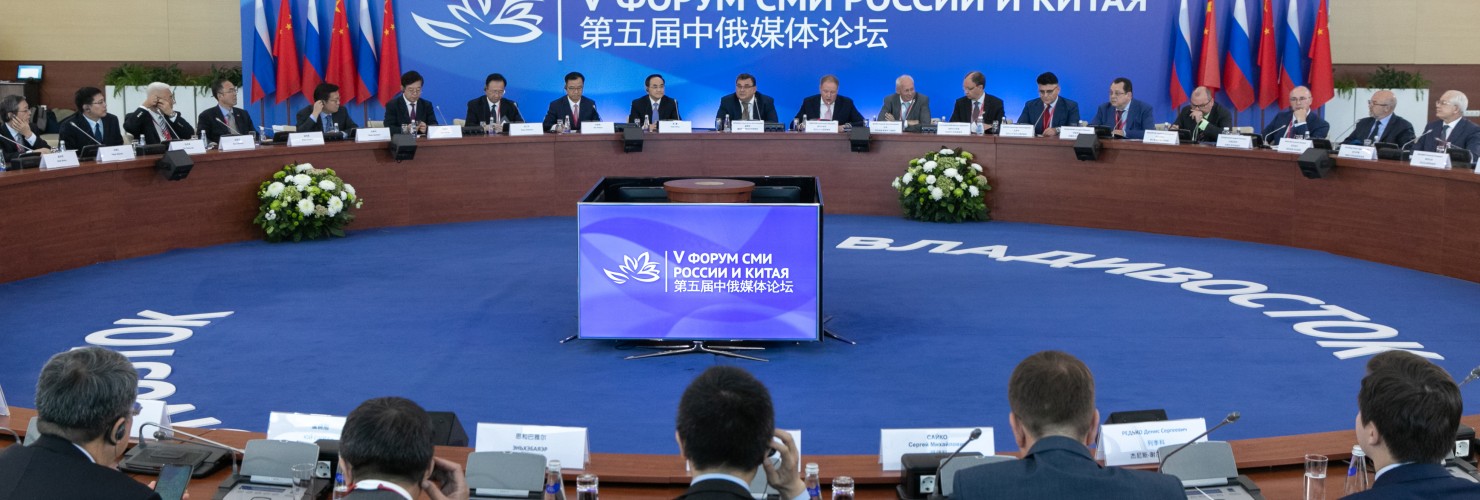

Chinese and Russian media partner to "tell each other’s stories well"
Beijing and Moscow have built a framework for media cooperation. Mayya Solonina* and Katja Drinhausen say the goal is to align narratives and shape perceptions at home and abroad.
On the sidelines of the Shanghai Cooperation Organization (SCO) meeting in Moscow in October, China’s and Russia’s foreign ministers called for strengthening bilateral media cooperation. Shortly after that, media representatives from both countries vowed to “report major international events in a comprehensive, impartial and objective way, and stay firm in opposing and resisting false information intended to stigmatize other countries” – especially in times of Covid-19.
This was the latest in a long line of steps in the field. Since 2015, China and Russia have held an annual Media Forum and in 2018 both countries’ state-affiliated media agreed to increase publication of material approved by the partner’s government. As part of the broadening strategic partnership between China and Russia, media from both countries have signed numerous cooperation agreements over the past years: People’s Daily, Xinhua, Global Times and China Media Corporation have joined hands variously with RT, Russia Channel One, TASS and Sputnik on the Russian side.
Media-matchmaking serves to amplify viewpoints domestically and globally
The aim of this media-matchmaking spree is to join forces and “tell each other’s stories well”, as Chinese state media have put it – to work together to promote each other’s viewpoints, values, interests. One objective is to strengthen the image of the partner domestically. But the pact also explicitly aims to shape perceptions and public discourse around the world, especially in the Global South. China Global Television Network (CGTN) reaches 85 million viewers worldwide and RT more than 350 million, to name just two outlets that offer content internationally.
The underlying assumption is that as China and Russia become more powerful, they have to gain a stronger voice in international public opinion in order to challenge Western dominance over global values and governance.
Collaboration takes many forms. Local reporters are meant to draft stories for the partner country. Media have pledged to pool international resources by exchanging or drafting content together and developing apps and platforms. Joint training and exchanges between key personnel are also meant to align narratives and presentation of current events and viewpoints by traditional and new media.
The US is painted as the main adversary, the EU still as a potential ally
This collaboration appears to be bearing fruit. A reading of both countries’ state-affiliated media reveals that Russian media reports on China largely mirror Beijing’s perspective, and vice versa. Russian media have aired a series of news reports and documentaries that furthered the Chinese party-state’s storylines about Hong Kong and Xinjiang. In turn, coverage of the recent constitutional reform in Russia saw Chinese media stick to the official Russian representation.
But these media outlets not only present the other country’s policies in a good light – they work together to create common friends and enemies. Chinese and Russian headlines show how media in both countries are in synch in portraying the US as a common adversary, often in dismissive and sarcastic language, while signaling mutual support in pushing back against this adversary. After the US election, both sides played up the flaws of the US electoral process and focused on the decline of the USA’s geopolitical dominance.
In comparison, the European Union gets portrayed in a much more diverse light, depending on what’s at stake. For instance, an article in China’s People’s Daily about accusations of a Russian cyber-attack on EU institutions refrained from presenting a clear opinion. Russian news coverage took a tougher line, but did not use the adversarial tone almost routinely used for news involving the US. In contrast to this more reserved coverage, the visit of a Czech official to Taiwan sparked strong condemnation from Chinese media – and Russian media followed suit.
Collaborations like this aren’t only a part of the Chinese-Russian relationship. From Brazil to Italy and Zambia, China has been keen to strengthen cooperative reporting.
The effects on domestic and global perceptions should not be underestimated
Media commentators and academics have argued that an official push like this has limited impact on burnishing China’s image in Russia or vice versa. But Chinese and Russian media outlets that present alternative points of view are scarce. In both nations, official news channels play a key role in presenting global events and determining the image of the main international actors. Russian citizens still perceive China more highly than those of any other country in Europe – 60 percent of Russians have a positive or very positive view of China.
More importantly, the analysis of media narratives shows that the cooperation is much less focused on creating a good image than it is on building up joint threats. Put simply, to garner public support for the Sino-Russian strategic relationship and each state’s actions on the global stage, the citizens of China and Russia don’t have to love the other country – they just have to be united against joint enemies. This dynamic is visible in international media landscape, where China and Russia have been ramping up their presence and reach. Positive spin about both states’ policies is accompanied by criticism of an unjust Western and US-centric international order that is well past its prime.
The relatively friendly coverage the EU receives is likely due to its more restrained foreign policy and the fact that it is one of the biggest trading partners of both China and Russia. But there is every reason both country’s media could turn against the EU as it reappraises its stance towards China and Russia and takes a more confrontational line on a range of issues – from international trade to human rights. The EU needs to be aware of the dynamics and international amplification of messaging, and be ready to tell its side of the story to global audiences.
* Mayya Solonina was an intern in the Politics and Society program at MERICS from July until October 2020. Before coming to MERICS, she was a working student at the German Institute for Global and Area Studies (GIGA) Berlin Office. She holds an MA in Chinese studies from the University of Würzburg and a BA from National Taiwan Normal University.
